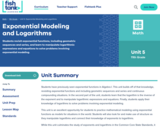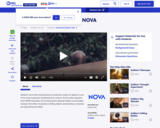
Students look at making wise consumer decisions by figuring out what is the better deal.
- Subject:
- Mathematics
- Material Type:
- Lesson Plan
- Provider:
- BetterLesson
- Date Added:
- 12/01/2022

Students look at making wise consumer decisions by figuring out what is the better deal.

Which drink has the strongest caffeine concentration? Students work on this problem for the second of two lessons.

This Cyberchase video segment features Bianca, who must figure out the fastest route to a movie premiere.

Provides historical unemployment data for state and metropolitan areas of the United States.

Video provides examples of how to calculate speed and velocity. [11:45]
Khan Academy learning modules include a Community space where users can ask questions and seek help from community members. Educators should consult with their Technology administrators to determine the use of Khan Academy learning modules in their classroom. Please review materials from external sites before sharing with students.
![Centre for Education in Mathematics and Computing: Ratio and Rate [PDF]](https://openspace.infohio.org/static/newdesign/images/materials/default-thumbnail-index.png)
Learners explore the concepts of rate and ratio in a variety of problem-solving situations. Worksheets contain definitions and visual representations of concepts. Link to related ratio game. Other skills include measurement, data analysis, and number sense. Acrobat Reader required.

The CyberSquad tracks Digital position in time and then studies graphs to figure out what Hacker is scheming in this video from Cyberchase.

Harry estimates how long it will take him to get to the front of a long ticket line in this Cyberchase video segment.

Students revisit exponential functions, including geometric sequences and series, and learn to manipulate logarithmic expressions and equations to solve problems involving exponential modeling.

The CyberSquad tests which broom can travel the furthest in five seconds in this video from Cyberchase.

The CyberSquad tests which broom can travel the furthest in five seconds in this video from Cyberchase.

Determine the rate of change from tabular data then check understanding with a short quiz. [2:02]

In this video segment from Cyberchase, Harry decides to train as a firefighter and uses line graphs to chart his physical fitness progress.

How did Galileo figure out the mathematics of falling bodies? This video segment adapted from NOVA examines Galileo's work on motion. [4:00]

Students take on the role of geographers and civil engineers and use a device enabled with the global positioning system (GPS) to locate geocache locations via a number of waypoints. Teams save their data points, upload them to geographic information systems (GIS) software, such as Google Earth, and create scale drawings of their explorations while solving problems of area, perimeter and rates. The activity is unique in its integration of technology for solving mathematical problems and asks students to relate GPS and GIS to engineering.

In this lesson designed to enhance literacy skills, students learn how to read and interpret a distance–time graph.

In this video segment from Cyberchase, Inez estimates whether she has enough jelly beans in her large container to decorate all of the cookies in her batch.

Brush up on your math skills relating to unit rates then try some practice problems to test your understanding.

In this interactive, students use clues and logic to plot the location of aquatic animals on a Cartesian graph that represents the four cardinal directions. The three riddles in the interactive, including one that requires students to understand rate, have randomized values so that students can practice placing points at different locations on the graph. The accompanying classroom activity provides students with a review of locating points on a Cartesian graph. A response sheet helps students work with the interactive.